Yes, they are busy, those bees.

This one, with pollen basket already stuffed full, is still on the job for more.
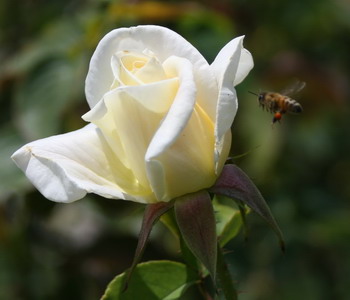
Now I can spend the afternoon trying to figure out the source of that pollen. Drat, I should have asked the bee.
Yes, they are busy, those bees.

This one, with pollen basket already stuffed full, is still on the job for more.

Now I can spend the afternoon trying to figure out the source of that pollen. Drat, I should have asked the bee.
Two more examples of fabulous signs in prime Googie style.
Bob’s Big Boy in Burbank:
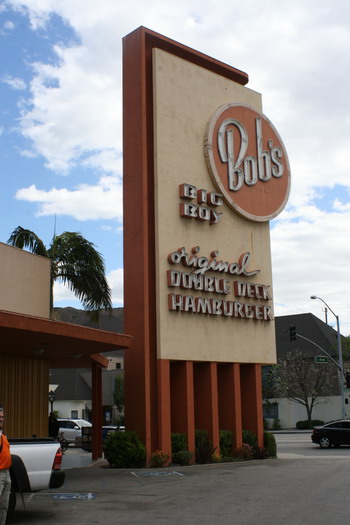
This is actually the very first building done for the chain by architect Wayne McAllister; it’s been sitting there in Burbank since 1949 and was declared a California Point of Historical Interest in 1993. Which is more than merited, because McAllister and his very distinct take on form, function, color and fun paved the way from Streamline Modern to Googie.

Bob’s Big Boy in Burbank was designed as a drive-in and the present owners revived the car-hop service (at least on weekends). They also restored the Big Boy’s sign to its full glory. Well done, I say.
Another chain of diners, very unique to SoCal, is Norms:

This sign is already a slightly later adaption of the original style, which can be seen here. But the basic strong language of form and color never changed, which is laudable. The first Norms was designed by the architectural firm of Armet & Davis, a company enormously influential in defining this very Californian style of the ’50s.
And yes, Norms never closes – since 1949.
So we finally made it to the Hoover Dam. We were prepared to be impressed. And we were, when we saw this:

This is the new Hoover Dam Bypass; work started in 2005, it is scheduled to be finished in 2010. Then one will travel 840 feet (256 m) above the Colorado River on a four lane highway.
Two more closeups:
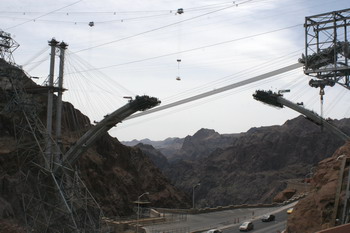

The Hoover Dam itself is a marvel of engineering, given the time it was built and the enormity of the task involved. But the new bypass is just overwhelming. Or WOW! With a well-deserved exclamation mark.

Plane landing at Las Vegas Airport
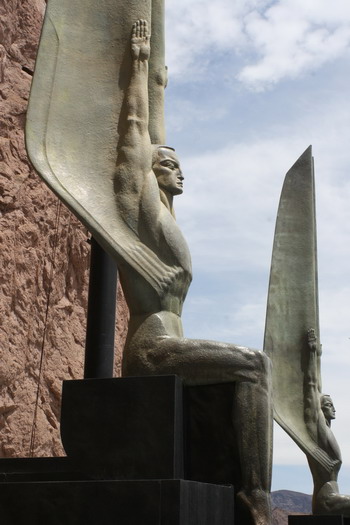
“Winged Figures of the Republic” by Oskar J.W. Hansen at Hoover Dam
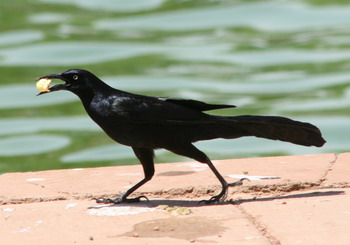
Greedy Grackle
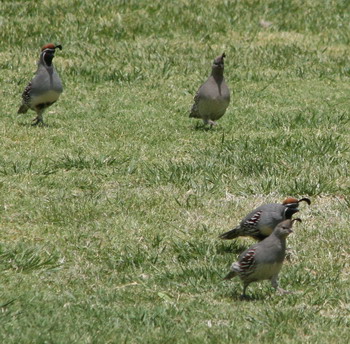
Flock of California Quail
While Mom is out and about looking for food (or taking a break from parenting)

the youngsters are staying close to home.

After all, the first lesson every Californian ground squirrel learns is: “If it has feathers and comes at you from above – go underground. Double quick!”
Grey squirrels in parks
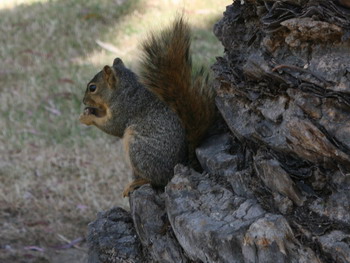
have a different strategy: “If it has feathers and comes at you from above – climb a tree. Double quick!”
Out of Art Deco, enthusiastically adopted in the US, grew a style unique to the United States – Streamline Moderne. It evolved in the ’30s and was both a modern continuation and a reaction to Art Deco, which surprisingly enough is not a contradiction, although at first it seems to be one.
Streamline Moderne reflected the more austere economic times of the ’30s. Some Art Deco elements were kept, but generally sharp angles and lines became more aerodynamically rounded, excessive ornaments gave way to clean surfaces and – very important – modern materials like cement and glass were used to replace exotic woods and stone.
In Los Angeles the Lydecker House is usually quoted as a prime example of a residential building in the Streamline Moderne style. But there are many, many private houses around showing the rounded lines, the curved windows, the portholes so typical of that style.

Even more houses show only some of the elements – just some curved lines, one or two porthole windows; that was enough at that time to deem the house “modern” and satisfy the buyer that he or she was totally “with it.”
And then one can find something like this:

Here the theme of the rounded lines and the portholes has been taken to a certain extreme, in keeping with the name “The Good Ship Grace.” This building was originally a radio station for Christian broadcasting. Then the radio station moved out to Riverside and the structure just sits there – empty and as an example of a very unique American style.
The hot Sunday was followed by a broiling hot Monday. Due to the winds coming in from the Mojave Desert, temperatures in Downtown Los Angeles rose to 100°F (37,7°C). The forecast for today is just a bit lower, back to 94°F.
It is a bit difficult to keep cool or at least comfortable, if one hates A/C. But it is possible.
This beautiful Husky however had every reason to look a bit downtrodden and less energetic than Huskies usually do.
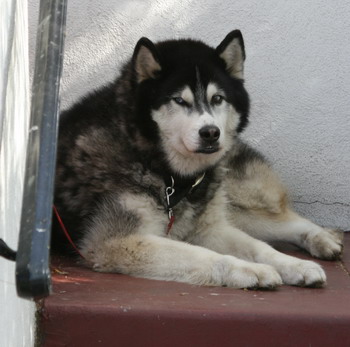
I looked at him, he looked at me, and I could read his mind: “Los Angeles in summer is not a good place to be. Heck, most of the time it’s too hot for me even in what you call winter!”
With the weather report forecasting high temperatures of up to 93°F, we started early on our hike in the Deukmejian Wilderness Park. This park is another one of those lovely areas which escaped the fate of being “developed” through the City of Glendale buying the land and turning it into a recreational area.
It took only a very short while to discover a patch of green, dotted with lovely yellow flowers.

It turned out that these pretty little things are Ice Plants (Carpobrotus edulis), quite aggressive invaders. Brought to California in the early 1900s as a stabilizer for soil along railroad tracks, Caltrans was one of the companies who planted thousands of acres of it all over Southern California. C. edulis, originally from Africa, took a good look around, decided that SoCal was just the place to be and started doing what C. edulis does best – it spread. And spread. And spread some more. Today the plant has become a serious ecological problem, posing a threat to the local flora and has to be fought.
The next pretty sight was the Californian State flower, the Golden Poppy (Eschscholzia californica).
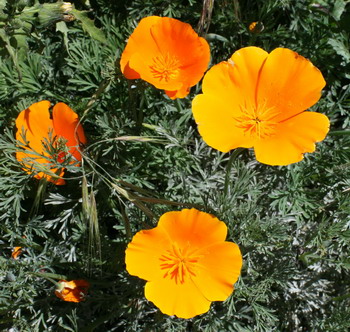
Now this truly is a native plant and always lovely to look at. Not that the Ice Plant isn’t lovely, but I found it quite interesting to see two plant species only about 20 paces apart from each other – one an intruder, one a native.

I bet that the driver of this car is female and was pretty excited when Daddy presented her with the car.
Somehow I do not see males declaring their affection for the sponsor of the vehicle they drive on their license plates.
But then again, I might be wrong.
Even before the first Mini (the car, that is) appeared on the scene in the UK, the Italians already had their first ‘micro car” out and running: the Fiat 500.
Fiat started building the Fiat 500 in 1957 and continued this model until 1975. Minor modifications were made, but basically the Fiat 500 stayed what it was planned to be: a cheap, tiny car with a 2-cylinder air-cooled motor with a maximum speed of about 70 miles per hours. In short – and that can be taken literally with a length of less than 3 meter (116.9 in) – it was the perfect city car.
And not only that, people traveled in these little cars. Not the distances one is used from the US, but I remember that an aunt of mine came up to the North of Germany from near Munich with one of these tiny little things; and that would have been a distance of roughly 500 miles.
So imagine my delight when I saw this cutie today in front of a Trader Joe’s:
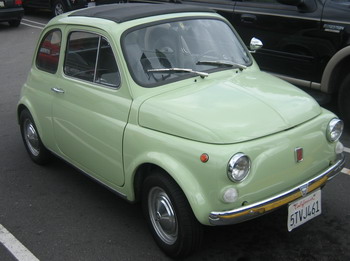
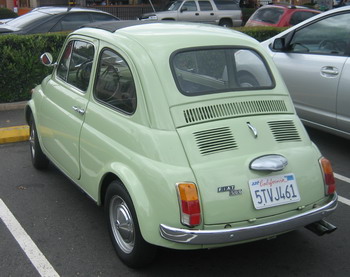
Somehow it gave the expression “mint condition” a totally new meaning; and reminded me of those days of my youth when a Fiat 500 was not a rare exotic vehicle, but an everyday car you saw at every corner.